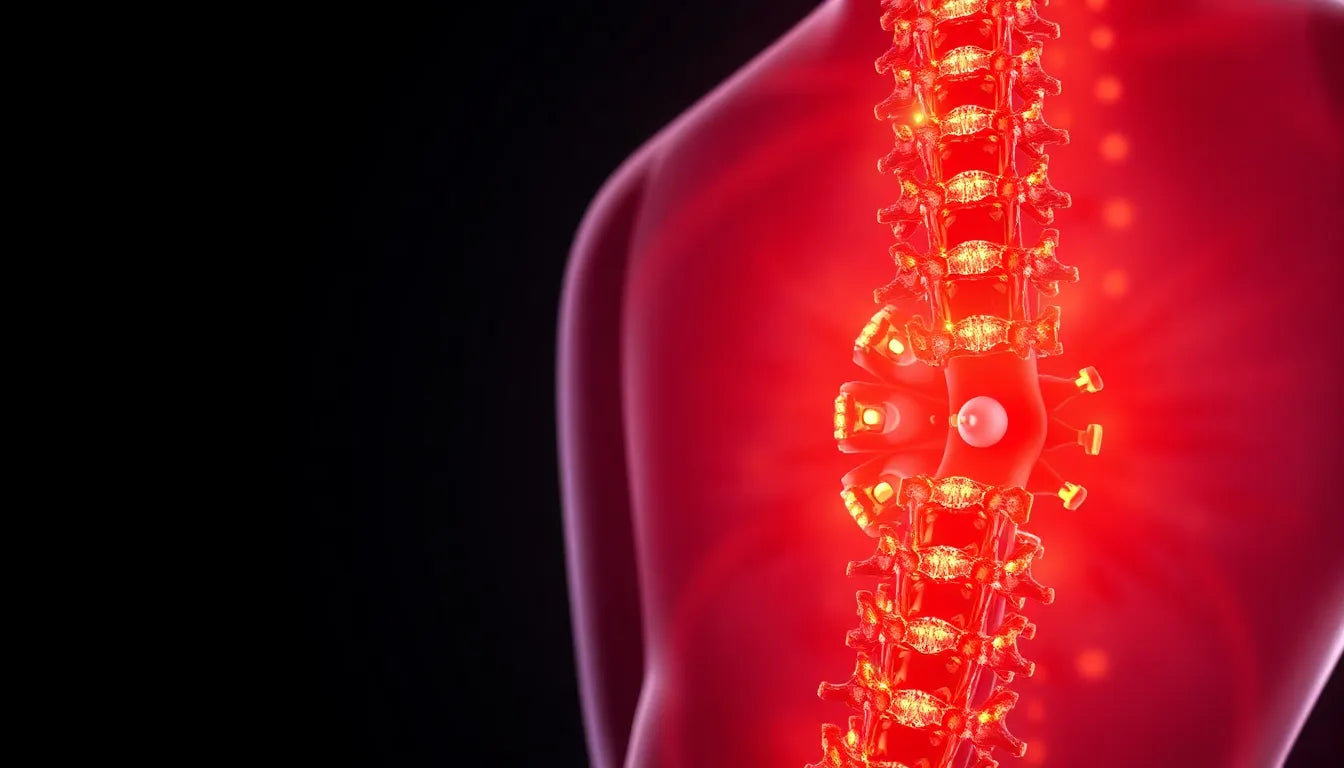Understanding the intricacies of an early stage herniated disc in the lower back is crucial for effective management and relief. This condition, often affecting the lumbar region, occurs when one of the intervertebral discs, which act as cushions between the vertebrae, begins to bulge or rupture, potentially pressing on nearby nerves. The spine's anatomy is designed to provide both flexibility and support, with these discs playing a vital role in absorbing shock and facilitating movement. Recognizing the signs early can prevent further complications and enhance recovery outcomes.
Recognizing early symptoms of a herniated disc
In its initial stages, a herniated disc in the lower back typically presents with localized pain, often described as a dull ache or sharp discomfort in the lumbar area. As the condition progresses, the pain may extend beyond the lower back, manifesting as radiating leg pain, commonly known as sciatica. This occurs when the herniation impinges on the sciatic nerve, leading to symptoms such as numbness, tingling, and even mild leg weakness. These symptoms can be exacerbated by certain movements or prolonged periods of sitting, with intensity levels fluctuating throughout the day. Interestingly, some individuals may experience atypical symptoms in less obvious locations, underscoring the importance of thorough evaluation.
The importance of early intervention
Addressing an early stage herniated disc promptly is vital for preventing long-term complications and promoting recovery. Early management strategies can significantly improve outcomes, reducing the likelihood of chronic pain and nerve damage. This blog post aims to provide a comprehensive overview of the symptoms, diagnostic processes, and management strategies for those dealing with this condition. By understanding the nuances of a herniated disc, individuals can take proactive steps towards alleviating pain and restoring their quality of life.
Diagnosis of early stage herniated disc
Identifying an early stage herniated disc in the lower back begins with a comprehensive physical examination by a healthcare professional. During this initial assessment, doctors often conduct various tests to evaluate nerve involvement and determine the extent of the condition. One such test is the Straight Leg Raise (SLR), which involves raising the leg to assess the presence of pain, indicating potential nerve compression. This simple yet effective test helps in pinpointing the affected area and guides further diagnostic steps.
When physical examinations suggest a herniated disc, imaging techniques become crucial for confirmation. Magnetic Resonance Imaging (MRI) is considered the gold standard for diagnosing herniated discs, as it provides detailed images of the spine's structures, revealing any disc abnormalities and nerve impingement. While X-rays are less detailed, they may be used to rule out other conditions. Typically, imaging is recommended if symptoms persist despite conservative treatment, or if there are red flag symptoms requiring immediate attention.
Effective early stage treatment strategies
Managing an early stage herniated disc primarily involves conservative treatment strategies aimed at alleviating pain and preventing further injury. Rest and activity modification are fundamental, allowing the affected area to heal without additional strain. Incorporating ice or heat therapy can provide immediate relief by reducing inflammation and relaxing tense muscles. Over-the-counter anti-inflammatory medications are often recommended to manage pain and swelling effectively.
Physical therapy plays a pivotal role in recovery, focusing on safe stretching and mobility exercises tailored to the individual's needs. These exercises help strengthen the muscles supporting the spine, improving flexibility and reducing the risk of future injuries. In some cases, healthcare providers may prescribe muscle relaxants or stronger pain relievers to manage severe symptoms, though these are typically short-term solutions.
Most individuals experience significant improvement within 4 to 6 weeks of conservative treatment. During this period, symptoms gradually diminish as the disc heals, with reduced pain and increased mobility. Monitoring progress is essential, and any signs of improvement should be communicated to healthcare providers to adjust treatment plans as needed.
Preventive measures and lifestyle adjustments
Preventing the recurrence of a herniated disc involves adopting healthy lifestyle habits and making ergonomic adjustments. Maintaining a healthy weight reduces the strain on the lower back, while regular exercise strengthens core muscles, providing better support for the spine. Activities such as swimming, walking, and yoga are excellent choices, promoting flexibility and overall fitness without placing undue stress on the back.
Ergonomic advice is crucial for those with sedentary jobs or those who engage in repetitive movements. Ensuring proper posture when sitting or standing, using supportive chairs, and taking regular breaks to stretch can significantly reduce the risk of disc herniation. Additionally, incorporating specific stretches and exercises into daily routines can support recovery and prevent future issues. These exercises should be performed with care, focusing on gentle movements that do not exacerbate symptoms.
By implementing these preventive measures and lifestyle adjustments, individuals can enhance their recovery process and minimize the likelihood of experiencing future herniated disc episodes. This proactive approach not only alleviates current symptoms but also promotes long-term spinal health, contributing to an improved quality of life.
Differentiating herniated vs. bulging discs
Understanding the distinction between a herniated disc and a bulging disc is essential for appropriate management and treatment. Both conditions involve the intervertebral discs but differ in severity and symptoms. A bulging disc occurs when the disc protrudes outward but remains intact, often causing mild symptoms or none at all. In contrast, a herniated disc involves a tear in the disc's outer layer, allowing the inner gel-like substance to escape, which can press on nearby nerves and lead to more pronounced symptoms.
The symptoms of a herniated disc are typically more severe than those of a bulging disc, often including sharp pain, numbness, and weakness in the affected area. Treatment approaches also vary; while both conditions can benefit from conservative management, a herniated disc might require more intensive interventions if symptoms persist. Visual aids, such as diagrams, can help illustrate these differences, offering a clearer understanding of each condition's impact on the spine.
When to seek medical attention
Recognizing when to seek medical attention for a herniated disc is crucial to prevent complications. While many cases improve with conservative treatment, certain symptoms warrant immediate care. These include severe pain that does not improve with rest or medication, significant weakness or numbness in the legs, and loss of bladder or bowel control, which may indicate cauda equina syndrome—a rare but serious condition requiring urgent intervention.
If symptoms persist or worsen despite treatment, it is advisable to consult a healthcare professional for further evaluation. This may involve additional imaging or a referral to a specialist for potential surgical options. Timely intervention can prevent long-term damage and facilitate a more effective recovery process.
Frequently Asked Questions
What is the main cause of a herniated disc in the lower back?
The primary causes of a herniated disc include age-related degeneration, which weakens the disc over time, and sudden movements such as lifting heavy objects or twisting the spine. These actions can increase pressure on the discs, leading to herniation.
Can a herniated disc heal on its own?
Yes, many herniated discs can heal naturally over time. The body can reabsorb the herniated material, and symptoms often improve with conservative treatment, such as rest, physical therapy, and medication, within a few weeks to months.
What activities should be avoided with a herniated disc?
To prevent exacerbating symptoms, it is advisable to avoid activities that strain the back, such as heavy lifting, high-impact sports, and prolonged sitting or standing. Instead, focus on low-impact exercises that promote healing and strengthen the back muscles.
Are there any long-term effects of a herniated disc if left untreated?
If a herniated disc is left untreated, it can lead to chronic pain, persistent nerve damage, and potential mobility issues. Early intervention is crucial to prevent these long-term complications and improve quality of life.
How can ergonomic aids help in managing a herniated disc?
Ergonomic aids, such as supportive chairs, adjustable desks, and lumbar cushions, can significantly reduce strain on the back by promoting proper posture and alignment. These tools can alleviate discomfort and support the healing process, making daily activities more manageable.
Sources
- Spine MD. "Herniated Disc: Symptoms, Causes, and Treatment."
- Mayo Clinic. "Herniated Disk: Symptoms and Causes."
- Cleveland Clinic. "Herniated Disc: Symptoms, Causes, and Treatment."
- OrthoInfo (AAOS). "Herniated Disk in the Lower Back."
- Penn Medicine. "Herniated Disk: Diagnosis and Treatment."
- AANS. "Herniated Disc: Overview and Treatment."
- CORE Orthopedics. "Herniated Disc: Symptoms and Non-Classic Presentations."



